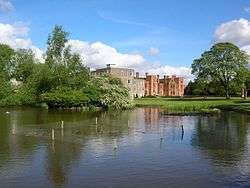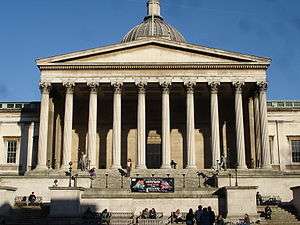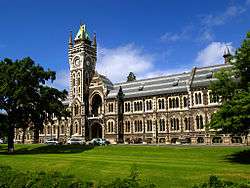Collegiate university
A collegiate university (also federal university or affiliating university) is a university in which governing authority and functions are divided between a central administration and a number of constituent colleges. Often, the division of powers in a collegiate university is realized in the form of a federation, analogous to the geopolitical arrangement in which a country comprises member regions (provinces, states, etc.) and a central federal government.
A collegiate university differs from a centralized university in that its colleges are not just halls of residence; rather, they have a substantial amount of responsibility and autonomy in the running of the university. The actual level of self-governance exercised by the colleges varies greatly among institutions, ranging from nearly autonomous colleges to dependent colleges that are integrated with the central administration itself. Often, but not always, colleges within collegiate universities have their own specific students' unions.
Loosely federated colleges
| The two founding colleges of the federal University of London | ||||
|---|---|---|---|---|
|
Some colleges are part of loose federations that allow them to exercise nearly complete self-governance. In the United Kingdom, the colleges of the University of London perform almost all the duties of a university with the exception of the awarding of degrees (although some of the larger colleges of the University of London, such as University College London, King's College London and the London School of Economics, have recently begun to award their own degrees). In the United States, many state university systems consist of campuses that are almost independent, spread out across different parts of the state. Examples of such institutions include the University of California, the State University of New York, the University of Michigan and the University of Texas System. The University of the Philippines started as one campus but is now a similar system of "constituent universities". The four constituent universities of the National University of Ireland are, for all essential purposes, independent universities.
Over time, loosely federated schools may formally end their relations with the parent university to become degree-awarding universities. Examples include Cardiff University (formerly named the University of Wales, Cardiff) and Imperial College London. The University of Dundee and the University of Newcastle upon Tyne were colleges of the University of St Andrews and the University of Durham, respectively, before they became independent. A number of autonomous universities in South Africa were formerly colleges of the University of South Africa.
Independent and federated colleges

At some universities the colleges enjoy a significant degree of independence, but the central administration also has an active role in institutional affairs. Often the binding conditions of federation, affiliation or incorporation outline fixed responsibilities of individual colleges and the university. In some cases the university may own a part share of the controlling entity.
Independent colleges vary in the level of teaching that they provide, but they may create positions independently from the university and may provide their own funding for research. They also tend to play a large role in deciding admissions. Students become members of the University through membership in their particular college, and matriculation is often done through, or at the behest of, the colleges. At the undergraduate level, independent colleges usually provide most, if not all accommodation and bursaries. They often have their own halls for meals, libraries, sports teams and societies. This fosters loyalty to the college among its students—an undergraduate might state the name of his or her college before the name of the university when asked where he or she studied. This spirit is often maintained through college-based alumni organizations.
The two ancient universities of the Kingdom of England (and subsequently the United Kingdom), Oxford and Cambridge (collectively termed Oxbridge), are federations of autonomous colleges. The University of Oxford has 38 colleges and 6 Permanent Private Halls, which exist autonomously and run independent, supplementary academic programmes. The university requires all teaching staff and students to be members of one of these institutions. The University of Cambridge has 31 colleges, which have a significant role in providing independent supplementary tuition and are governed autonomously. These institutions represent a significant financial interest, having combined fixed assets of approximately £3.4 billion, in contrast to the university's central assets, which total approximately £1.9 billion.[1][2]
Ireland's only ancient university is the University of Dublin. Created during the reign of Elizabeth I, it is modelled on the collegiate universities of Cambridge and Oxford. However only one constituent college was ever founded, hence the curious position of Trinity College, Dublin today--though both are usually considered one and the same, the University and College are distinct corporate entities with separate, parallel governing structures and functions.
Of the 17 colleges at Durham University, St Chad's College and St John's College and Ushaw College are separately incorporated and independently governed, with their own supplementary academic support and academic staff. All four of Roehampton University's constituent colleges, Whitelands College, Southlands College, Digby Stuart College and Froebel College, are independently owned, although the university holds a number of relevant long-term leases.[3][4]
In the Americas, the University of Toronto has a collegiate system that took form in the early 19th century, modeled after Oxford.[5] The independent colleges include Knox College, Regis College, Wycliffe College, Massey College, St. Michael's College, Trinity College, Emmanuel College and Victoria College. The Claremont Colleges in California operate a hybrid federal-constituent system. All 7 colleges are independently governed: Pomona College, Scripps College, Claremont McKenna College, Harvey Mudd College, Pitzer College as undergraduate colleges as well as Claremont Graduate University and Keck Graduate Institute of Applied Life Sciences as graduate universities. Their founding model was based on that of the University of Oxford and they are linked through the Claremont University Consortium, though, unlike other constituent college systems, degrees are conferred separately by the seven constituent institutions and they exist as universities and liberal arts colleges in their own right. The colleges are spread over a square mile site and share certain departmental, library and research facilities. In addition, the five undergraduate colleges operate two intercollegiate athletic programs, with Claremont, Harvey Mudd, and Scripps forming one program and Pomona and Pitzer the other.
In New Zealand, the University of Otago has 14 colleges, of which 5 are independently owned and governed: Selwyn College, Knox College, St Margaret's College, Salmond College and City College. Both dependent and independent colleges provide their own supplementary academic programmes.
In Italy, the University of Pavia includes four independent colleges, of which the oldest are the Collegio Borromeo (founded in 1561) and Collegio Ghislieri (1567), and eleven dependent colleges administered by EDiSU. While degrees are conferred by the University and students are not required to be members of a college, at least some colleges offer additional courses and other academic programs in parallel to those offered by university faculties.
Dependent colleges
Some universities have built colleges that do not provide teaching but still perform much of the housing and social duties, allowing students to develop loyalty towards their college. Such colleges are planned, built and funded entirely by the central administration and are thus dependent on it, however they still retain their own administrative structures and have a degree of independence.

In the United Kingdom, the University of York is made up of nine colleges; the colleges play an important role in the pastoral care of the student body. Every student is a member of a college and staff may choose to join a college if they wish. All the colleges are of equal status, and has its own constitution. The day-to-day running of the colleges is managed by an elected committee of staff and student members chaired by the college's 'Head of College'.
The University of Durham is mix of independent and dependent colleges; most of the colleges are not independent of the parent university, as many of them were established later in the 20th century, without the endowment funds needed to be independent. Most were established by the university itself, whilst others were previously independent teacher training colleges, such as the College of St Hild and St Bede, or were incorporated as colleges after a period of existence as student associations, such as St Aidan's College, St Cuthbert's Society and Ustinov College (previously the Graduate Society).
In the United States examples include the colleges of the Stanford University, Harvard University, Princeton University, Yale University, Rice University.
In Australia the University of Melbourne has a residential college system.
The Chinese University of Hong Kong was founded as a loose federation of three colleges, but the founding colleges have since become dependent on the central administration, and new colleges have been established as dependent colleges.
Former collegiate universities

Some universities that once featured collegiate systems had gradually lost them to mergers and amalgamation, due to financial, political or other reasons. Examples include the following:
- At the University of St. Andrews, the colleges joined together to become St Mary's College, St Andrews for Divinity, the United College of St Salvator and St Leonard and St Leonard's College for postgraduates. The divisions are now largely administrative, although St Mary's retains a distinctive identity within the university and St Leonard's operates as a postgraduate society 'without walls'.
- The colleges of the former University of Paris were suppressed after the French Revolution. In the twentieth century, the university was split into 13 institutions (Paris I - Paris XIII). Some of these universities are currently in the process of forming new collegiate systems, such as Sorbonne Paris Cité University, Sorbonne Universities and HéSam.
- The Victoria University, which split into Victoria University of Manchester, University of Liverpool and University of Leeds.
- At the University of Coimbra, independent colleges much like the Oxbridge ones were created throughout the 16th, 17th and 18th centuries. They were abolished with the extinction of religious orders in 1836.
- The University of Salamanca had a number of Colegios Mayores (Colleges), that were abolished in 1807 when Napoleon invaded Spain.
References
- ↑ Trigg, Joe (2006-11-17). "Old, rich, landed and loaded" (PDF). Varsity. Old Examination Hall, Free School Lane, Cambridge, CB2 3RF, UK. pp. 6–7. Archived from the original (PDF) on 2007-09-26. Retrieved 2008-10-03.
- ↑ "Facts and Figures: key date - 2010 (poster version)" (PDF). University of Cambridge. Retrieved 3 Feb 2011.
- ↑ "Roehampton Partnership". Roehampton Students' Union. 21 Oct 2008. Retrieved 3 Feb 2011.
- ↑ "University signs historic Southlands deal". Roehampton University. 9 Aug 2010. Retrieved 3 Feb 2011.
- ↑ Alexander, William John (1906). The University of Toronto and Its Colleges, 1827–1906. Toronto: H. H. Langton, The University Library.


